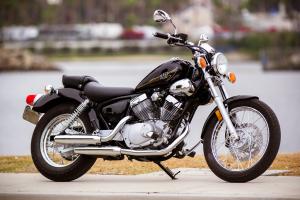2012 250cc Cruiser Shootout - Video - Motorcycle.com
“I haven’t ridden in eight years, so I feel like a beginning rider. Again.”
Those are the words of Melisa Ganzon, a long-time friend of Editor Duke. A graduate from the MSF Basic RiderCourse more than 11 years ago, Melisa has three years of riding experience under her belt.
However, her extended absence from two wheels (to start a family), along with her petite female stature and willingness to step back up to the plate created an epiphany in our collective Motorcycle.com mind: Melisa is an ideal candidate to participate in our 250cc Cruiser Shootout.
Pint-size Cruisers, Beginner Bikes, or Both?
The 250cc cruiser class is stunningly limited, and two of the three bikes in this battle should ring familiar with any rider who’s been around for a few years: the Honda Rebel and Star’s V Star 250.
Suzuki also has an offering in this segment, or at least used to, with the GZ250 that’s powered by a 249cc, air-cooled, carbureted single-cylinder. Unfortunately the last model year that Suzuki imported the GZ was for 2010, so that leaves one less offering from the Big Four, while Kawasaki doesn’t even bother entering a model in this class. Until recently the Honda and Star essentially were the 250cc cruiser class, but a new player has emerged in the small-displacement streetbike segment.
Cleveland CycleWerks (CCW) is an Ohio-based motorcycle design company founded in 2007 by owner Scott Colosimo. With four current models in the CCW lineup, it’s tha Heist that fits this shootout.
Although the Chinese-manufactured 229cc air-cooled, carbureted Single (found in all CCW models) that powers the bobber-themed tha Heist is a few cubic centimeters shy of the Star’s 249cc air-cooled V-Twin, the CCW engine makes for a diverse mix of motorcycles when we also factor in the Honda Rebel’s 234cc air-cooled, parallel-Twin. This trio of 250-ish motorcycles, each with a different engine configuration, represents what’s available for riders shopping pint-size cruisers.
With a quarter-liter or less of engine capacity, the modest levels of power produced by each engine make them appealing to newbie riders. But even experienced, price-conscious riders shopping for a gas miser should find that there’s enough go-juice on tap – even from the least of the three – to allow sufficient acceleration to stay ahead of city traffic. Nevertheless, with respect to engine power we have a clear winner.
With a best showing of 19.3 horsepower and 14.0 ft-lb of torque, the V Star 250 is the bike with the most potent engine at any point in the rev range. Next up is the Honda with 16.5 peak horsepower and 12.0 ft-lb of torque. The dyno charts reveal the V Star is always ahead of the Rebel, yet the Honda at times felt equally as peppy and willing to rev as the Star, making the V Star’s modest power advantage less discernable from the saddle than on paper.
Despite a displacement deficit of less than 10% to the Star, tha Heist is down considerably on power. The CCW machine managed a best performance of 11.5 hp and 10.5 ft-lb.
Tha Heist’s nearly 8 less horsepower compared to the V Star is notable, however, when the difference is viewed in terms of percentages tha Heist looks anemic – it makes a whopping 68% less peak horsepower than the Star. Tha Heist’s torque figure is more competitive, yet it’s still one-third less torque compared to the Star, and 14% less than the Rebel. In some ways, though, it gets worse from here for tha Heist.
In the interest of full disclosure we have to explain that the dyno results for tha Heist aren’t really from tha Heist we rode.
Our Heist test unit operated without any major foul ups during test rides. However, for reasons we, as well as Carry Andrew of Hypercycle, couldn’t determine in a reasonable amount of time, tha Heist suffered some sort of electrical failure that prevented it from making spark, thereby meaning we couldn’t dyno test the thing. (Update: Actually, it turns out there was no electrical failure. We just found out tha Heist's sidestand safety switch allows the engine to crank over but kills spark to the engine, which made us suspect an electrical gremlin. All other sidestand safety switches we've sampled do not allow the engine to turn over, so this was an unusual case. We apologize for our error, but it was easy to make when the Honda and Yamaha were purring away while resting on their sidestands.)
Since all CCW motorcycles use the same engine, for academic purposes we borrowed a previous dyno run from tha Misfit. We assume its dyno run would’ve been a near mirror image of what tha Misfit produced. There, elephant’s outta the room.
The differences between the bikes’ engine performances are fine for some armchair quarterbacking, but perhaps what carries greater significance in this arena are things like engine character, clutch and transmission operation, throttle response, etc. And when impressions from re-entry rider Melisa, as well our own Tom Roderick are plugged into this three-bike equation, raw engine numbers take a back seat to the motorcycles’ various other qualities.
More by Pete Brissette
































Comments
Join the conversation